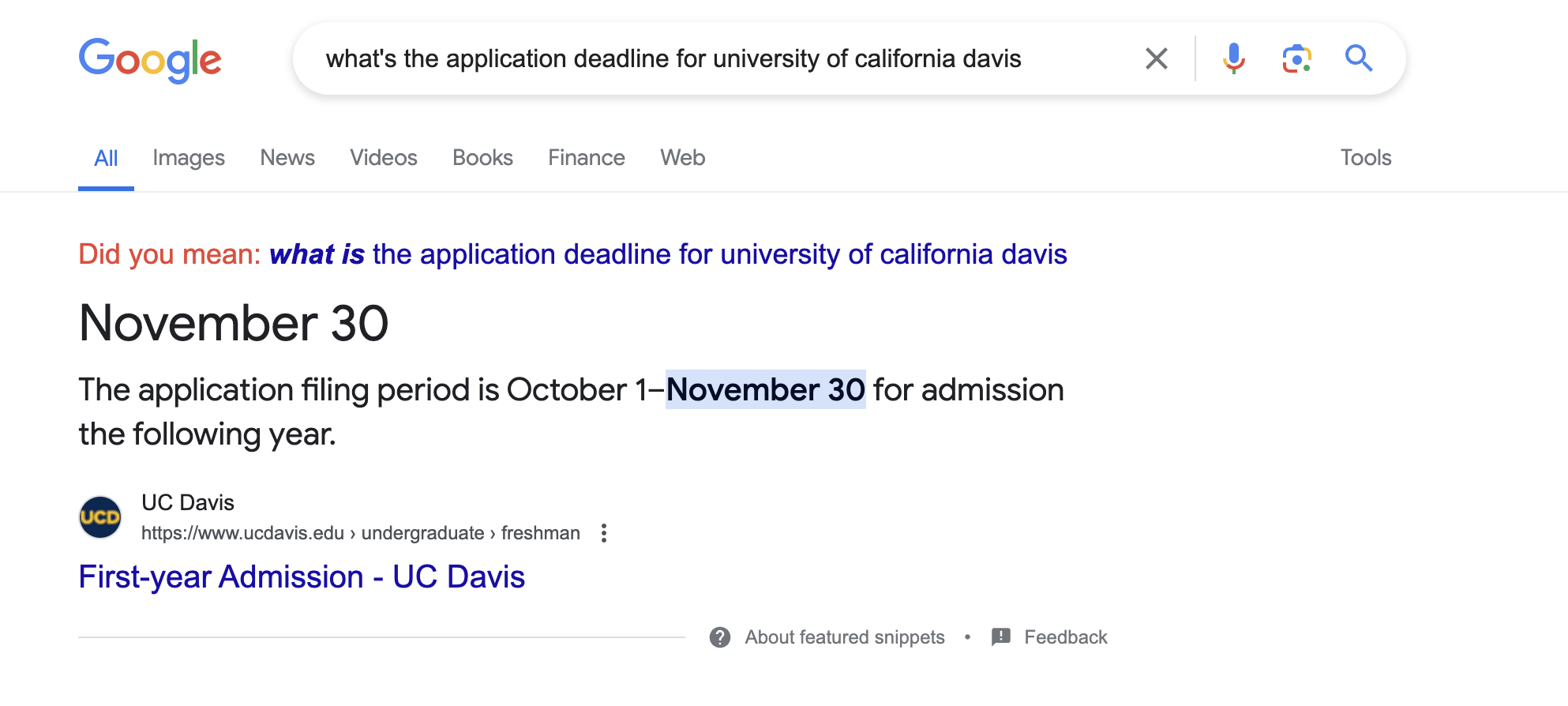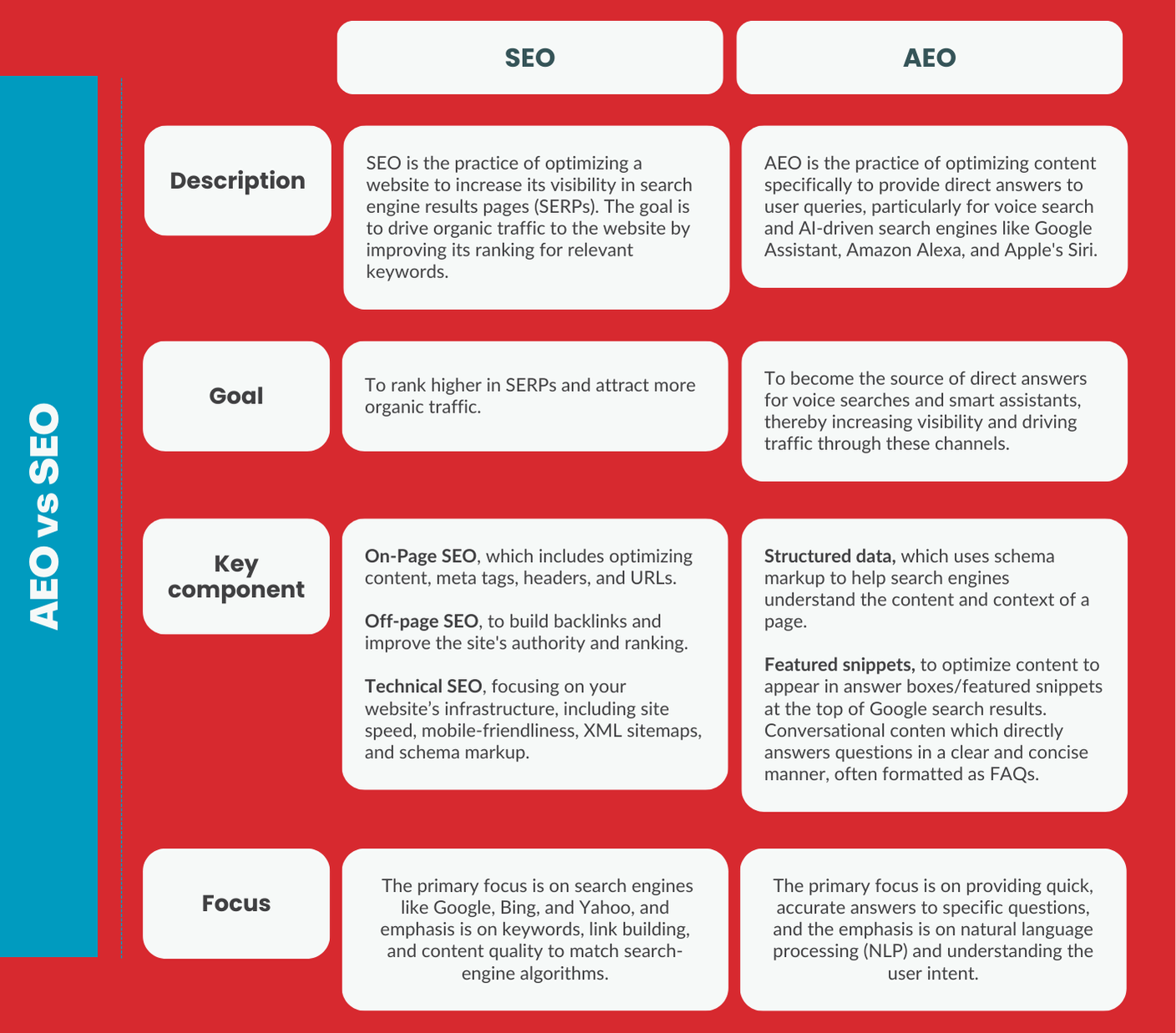Say hello to the newest member of the higher education digital landscape: AEO, short for Answer Engine Optimization.
Search engine optimization (SEO) has long been the focus of so many digital marketers to help students search, but recent trends with voice search, virtual assistants, and AI, there’s more demand for fast, direct answers for search.
This is where AEO comes in, which is all about optimizing content to deliver quick, succinct (and accurate) answers that can be given within search engine results.
Users who use conversational natural language queries (often using I-driven platforms like Google
Assistant, Siri, or Alexa) instead of typing keywords into a search bar expect immediate answers that are relevant.
Years ago, we noted the trend towards AEO in an article on the future of voice search (Is Your University or College Prepared for the Voice Search Revolution?), discussing how educational institutions need to adapt to the increasing use of voice search or conversational search by prospective students.
Back then, we highlighted the importance of optimizing content for voice search and using structured data to ensure that voice assistants can easily access and relay critical information such as application deadlines, tuition fees, and program details.
And while conversational search is growing, traditional keyword-based search is still very widely used.
By optimizing your content for AEO, your university or college can improve the visibility and accessibility of your information for prospective students and other users who use conversational search using complete sentences.
Now is the time to get your content ready.
Here’s how.
What is conversational search, exactly?
In the early days of traditional search, students type queries into a search bar (e.g. Google), which produces search engine results pages (SERPs) with numerous links to relevant websites.
They would scan the results, click on a useful-looking site, and read through it to find the needed information.
And despite Google and other search engine algorithms improving the results over time, when you think of it, it’s not really a great search experience.
But it’s what we knew.
Then voice assistants like Siri and Alexa came on the scene and have changed search behavior, and they use natural language processing (NLP) to deliver a short and accurate answer.
And now, AI-powered search offers a new way to search with Google and Bing leading the way.
AI-powered search is a new and advanced way of searching the internet that uses artificial intelligence (AI) to provide more accurate and personalized results using machine learning and natural language processing to understand the context and intent behind a search query.
These days, students are more likely to use full sentences to search, for example, instead of searching "university application deadline," a student might ask, "What’s the application deadline for the biology program at University X?"
And these results are often also delivered in conversational format, with the AI engine providing a summary or explanation rather than just a list of links (obviously, with varying degrees of quality, relevance, and reliability).
It’s the zero-click search revolution.

An example of conversational search and resulting zero-click snippet
To help students who use complete questions to search for information about your university or college, you can use AEO to structure your content so it’s easy and accessible for voice assistants, so they process it and respond.
This is especially important for frequently searched-for content, like application deadlines, tuition fees, or program requirements.
How are SEO and AEO different?
SEO is broader, aiming to improve overall search engine rankings and visibility, while AEO is more focused on providing direct answers to user queries, particularly for voice search and AI-driven interfaces.
You already know how SEO involves a mix of content, technical, and link-building strategies. AEO, on the other hand, emphasizes structured data, featured snippets, and conversational content.
So while with SEO, you’re aiming to get your university ranked higher and get more organic traffic from traditional search engines, with AEO, you’d try to to create immediate answers to questions, optimizing for voice search and smart assistants.
The one doesn’t negate the other—on the contrary, a successful strategy would include both and complement each other.
As search behavior evolves, especially with the rise of voice search, integrating AEO into an SEO strategy can help you provide a better search experience for students.

10 steps to implement an AEO strategy for higher education
Prospective students, parents, and other stakeholders often have specific questions about programs, campus life, admissions processes, and financial aid.
And many of them are using conversational search. So here’s how you can implement an AEO and content repurposing strategy soyour school can become the go-to source for these answers, and help increase engagement and conversions in the long run.
1. Combine your AEO with your regular SEO
To maximize your online presence and visibility, it's crucial to integrate your AEO strategy with your traditional SEO efforts.
By combining AEO with SEO best practices, you can get better search engine coverage across various platforms and search types, and be ready for the next batch of students searching using natural language.
Here’s how:
- Align your keywords and content strategy: Incorporate long-tail keywords and question-based queries that are likely to trigger answer box results (complementing your existing keyword strategy for organic search rankings).
- Enhance the student search experience: Go beyond keywords and look at your school’s website's structure and navigation—optimize it for easy access to answers, with headings, bullet points, and clear formatting to enhance readability and accessibility…everywhere.
So instead of only optimizing for broad keywords like "university admissions," include specific questions such as "What GPA is required for admission to [my university]?"
This approach not only improves your chances of appearing in answer boxes but also enhances your overall SEO strategy by targeting detailed user queries.
2. Optimize content for featured snippets
Featured snippets, also known as answer boxes, are the brief answers that appear at the top of Google’s search results.
They’re the coveted “position zero” spot, since it’s the first thing that a student sees when search results are returned.
Essentially, you want to identify common questions that students have and provide clear, quick answers, ideally with headings and subheadings, and in bullet points or numbered lists.
We’ve written before on this subject, so check out these two articles as a refresher:
- Mastering Google Snippets for higher education - Part I
- Mastering Google Snippets for higher education - Part II
As an example, if a prospective student wants to know the acceptance rate at your school, there should be a corresponding, piece of content with an easily found answer like, "The acceptance rate at [Your University] is 45%."
(One thing to look out for is that if your results appear as featured snippets, you may notice fewer site visits, since students could find answers to their questions without actually visiting your site. But as long as you’re seeing conversions, you’re still on the right track.)
3. Create FAQs
Frequently Asked Questions (FAQs) pages are really useful in an AEO strategy, because they anticipate the common questions your prospective students will have.
Similarly to snippets, you can identify these questions using tools (e.g. AnswerThePublic or
Google's People Also Ask feature—or even an AI search) related to your school, courses, admissions, and campus life.
Organize information logically and use bullets to improve readability—and don’t forget to add a call to action.
Keep your FAQs up-to-date as students’ search trends and questions change over time.
4. Implement structured data markup
Structured data, or schema markup, helps search engines understand the context of your content.
It offers explicit information about the type of content (such as courses, FAQs, events) and its attributes (like ratings, reviews), and this helps the search engines display richer results, including featured snippets and answer boxes, improving visibility and relevance in search engine results pages.
It also makes your web developer happy when marketing decides to repurpose content. (U
For example, you can use specific schema types relevant to higher education, such as:
- CollegeOrUniversity
- Course
- FAQPage
- Event
- Person
- Review
- Organization
- WebPage
- BreadcrumbList
Terminalfour tip: Use Google’s Structured Data Markup Helper.
5. Repurpose content as conversational content
Voice search queries are often more conversational and question-based.
This requires a small change to adapt your university content to match this style.
So rewrite content in a natural, conversational tone, using long-tail keywords that mirror how people speak.
For example, instead of optimizing solely for "best psychology programs," consider phrases like "What are the best psychology programs for international students?"
6. Focus on local SEO
Many prospective students search for institutions within a specific region or city, so local SEO is really important, especially for state colleges and universities.
Did you miss our blog article on this? Catch up here on local SEO strategies for higher education.
So get your Google My Business organized with updated information, encourage your alumni to leave reviews, and include tons of local keywords in your content and meta descriptions.
If your university is in Boston, for example, write content that includes phrases like "best university in Boston" or "top Boston colleges for engineering."
7. Monitor and adjust
AEO is an evolving field—as is all of higher ed marketing, really—so continuous monitoring and adjustment are going to be key.
Check your Google Analytics and Search Console specifically to track how your content performs in voice search and answer boxes, and stay updated with the latest trends in voice search and AI developments.
You’ll need to be ready to tweak your content and strategy based on performance data and emerging best practices.
8. Optimize for mobile search
Let’s not forget that many students these days are using mobile devices to get quick answers, so that’s also how your content needs to be optimized.
Make sure your website is highly responsive but also loads quickly on mobile devices.
And again, concise and easily digestible information is key for users on-the-go.
9. Leverage social media for engagement
Social platforms play a significant role in brand visibility and engagement, as higher education marketers well know.
So don’t forget social media when you’re creating your AEO strategy, as it can improve your reach.
We have tons of articles on how to stay up-to-date and best practices for social media.
See what higher education content is popular so you can share content answers common questions and addresses student concerns.
As you build your community, you can encourage more interaction and feedback.
10. Implement a comprehensive content strategy
Lastly, nothing beats a robust content strategy that focuses on high-quality content to support AEO.
Repurpose your best and most viewed content into podcasts, videos, blog articles, snippets.
Things are changing fast, attention spans are lower, and content is everywhere. Yours needs to be high quality and engaging to capture the attention of prospective students.
Address a wide range of relevant topics and questions, don’t skimp on keyword research (especially for long-tail keywords and question-based queries), and develop content clusters around core topics.
The future of search is here—ensure your institution is at the forefront.
Have you already developed an AEO strategy and optimized your content to provide direct answers?
Share your tips and best practices with our higher education community.

:format()//media/AEO-search-for-higher-education----RQ.png)